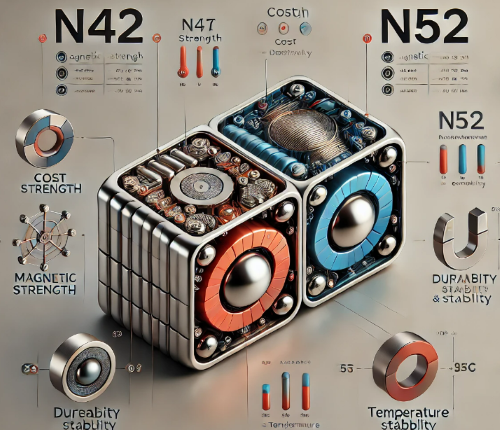
Introduction
Magnets, particularly Neodymium magnets, are vital components in a plethora of modern applications, ranging from consumer electronics to industrial machinery. Two common grades of Neodymium magnets are N42 and N52. While both offer significant magnetic strength, their differences in performance, cost, and suitability for various applications warrant a closer look. This article will compare the characteristics of N42 and N52 magnets, examining which might be better suited for specific needs.

Understanding N42 and N52 Magnets
Neodymium magnets are categorized by their grade, which indicates their maximum energy product, denoted as (BH)max, measured in MegaGauss Oersteds (MGOe). This metric reflects the magnet’s strength and energy storage capacity.
- N42 Magnets: These magnets have a maximum energy product of around 42 MGOe. They are known for providing a good balance between strength, cost, and versatility, making them a popular choice for many applications.
- N52 Magnets: These magnets possess a higher maximum energy product of approximately 52 MGOe, making them some of the strongest commercially available magnets. They can produce a more intense magnetic field compared to N42 magnets.
Stanford Magnets is a leading supplier of super rare earth magnets, specializing in the research, development, manufacturing, and sales of permanent magnets since the 1990s. We provide a wide range of rare earth permanent magnetic products, including neodymium magnets and various magnetic assemblies.
Strength and Magnetic Performance
The primary advantage of N52 magnets over N42 magnets is their superior magnetic strength. An N52 magnet can generate a stronger magnetic field, which can be crucial for applications requiring high performance and compact size. For example, in precision engineering or high-tech electronics, where space constraints and maximum efficiency are paramount, N52 magnets offer a clear advantage.
However, this increased strength comes with trade-offs. N52 magnets are more brittle and can be more prone to cracking or chipping compared to N42 magnets. Therefore, in environments where the magnet might be subjected to physical stress or impact, N42 magnets may be more durable and less likely to suffer damage.
Cost Considerations
Cost is a significant factor when choosing between N42 and N52 magnets. N52 magnets are generally more expensive than N42 magnets due to the higher cost of raw materials and the more precise manufacturing processes required to produce them. For applications where cost efficiency is critical and the magnetic strength of an N42 magnet is sufficient, opting for the N42 can provide substantial cost savings.
For instance, in large-scale manufacturing where thousands of magnets are needed, the cost difference between N42 and N52 magnets can become substantial. Therefore, unless the specific application requires the highest possible magnetic strength, N42 magnets often represent a more economical choice.
Temperature Stability
Another important consideration is the temperature stability of the magnets. Both N42 and N52 magnets can lose some of their magnetic properties at elevated temperatures. However, N42 magnets typically exhibit slightly better performance at higher temperatures compared to N52 magnets.
The operating temperature range for N42 magnets is up to about 80°C, while N52 magnets may start to experience performance degradation at slightly lower temperatures. For applications involving exposure to higher temperatures, N42 magnets might be more suitable.
Applications and Suitability
The choice between N42 and N52 magnets largely depends on the specific application requirements:
- N42 Magnets: Due to their balance of strength, durability, and cost, N42 magnets are widely used in general-purpose applications such as consumer electronics, magnetic fasteners, and DIY projects. Their relatively better performance at higher temperatures also makes them suitable for use in environments where moderate heat is a factor.
- N52 Magnets: These magnets are ideal for high-performance applications where maximum magnetic strength is essential. This includes specialized equipment, high-end audio devices, electric motors, and advanced technological applications where space is limited and high magnetic performance is crucial.
Conclusion
Determining whether N42 or N52 magnets are better depends on the specific needs of the application.
N52 magnets offer superior magnetic strength and are ideal for high-performance, space-constrained applications. However, they come at a higher cost and may be less durable under physical stress. On the other hand, N42 magnets provide a more balanced option, offering good magnetic strength, better durability, and cost efficiency. They are more suitable for general-purpose use and environments where higher temperatures might be encountered.
By carefully considering these factors, manufacturers and engineers can choose the magnet grade that best meets their requirements, ensuring optimal performance and cost-effectiveness. For more neodymium products, please send us an inquiry.
